Breaking Down the Dungeons and Dragons Character Sheet — Part 1
Understanding what a character sheet is, why you need it, and what goes on it
There are a ridiculous number of things that go into making and playing a D&D character. You have to know their race, class, age, temperament, skills, and every other tiny little detail down to how many coins they have in their backpack. Did you know that there are nearly 20 uniquely named skills to know that you’ll use regularly during gameplay?
So, clearly, there’s a lot of information here, and haphazardly writing it all down might work for you, but it probably won’t work for your poor DM. See, they have to keep track of everyone’s characters, including many of their own. And you might have to make a brand new character unexpectedly (hello, sudden death-by-mimic); if it takes you forever to build your character notebook, how are you going to do that?
That’s where the character sheet comes in.
Your character sheet is a uniform, organized way of presenting all of your character’s necessary information in one place. Your DM will know exactly where to look when trying to find your AC to hit you in combat, you’ve got a space to write down all of the awesome loot you get, and no one has to wait an hour for you to find out if your character’s Athletics score is a +1 or a -1. It’s a win on all fronts!
So, here are the basics of how character sheets are assembled. This is going to be a multi-part explanation; as I said, there are a LOT of things packed into this paper!
The Anatomy of a Character Sheet
For this explanation, we’re going to be looking at the standard sheet you can get from DndBeyond, Wizards of the Coast’s official website for the game. There are many versions of the character sheet, with the information moved around, but they’ll all have the same information on them.
Your character sheet is neatly organized into self-contained sections. These sections are:
- Your character’s basic information
- Their scores, saves, and skills
- Their battle stats
- Their battle actions
- Their inventory and spells
- Their story details
Here’s a quick rundown of each section. I’ll go into more detail about how to set them up and what they mean in later parts, but for now, let’s get what and where they are out of the way.
Character Basics

The very first section of the page is what I like to call the character basics section. In this part, you list your character’s name, race, class, level, background, experience (if you’re using it), and the player’s name. Think of this as your character at a glance.
This section is most useful for the DM, when they have to flip between sheets to find yours during a session or while planning. It helps them keep track of who’s playing who.
Stats and Skills

Next up are stats and skills. On a standard sheet, the character’s scores will be on the far left (or the very top). These scores determine your character’s ability to perform other functions of the game, including the modifiers attached to the other skills in this section.
Beside them will be their saving throws and skills. The fifth edition of Dungeons and Dragons details 18 unique skills outside of the six main ability scores:
- Acrobatics
- Athletics
- Deception
- History
- Insight
- Intimidation
- Investigation
- Medicine
- Nature
- Perception
- Performance
- Persuasion
- Religion
- Slight of Hand
- Stealth
- Survival
Below the skills section is a box containing your passive scores. These three scores — Perception, Insight, and Investigation — determine what you see in your environment without rolling. This box also contains any extra senses you have, like Darkvision or superior hearing.
On the other side of the sheet is a box labeled “Proficiencies and Languages;” this box details exactly what it says. It lists out the armor, weapons, and tools that your character is proficient with as well as the languages they speak.
Battle Stats and Health
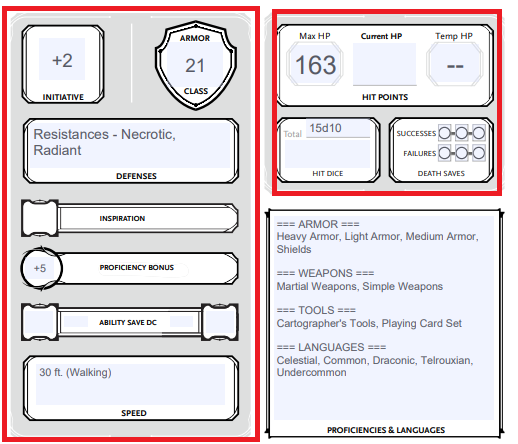
Now we’re getting into the fun stuff! Battle stats aren’t just for battle, but they are key information that you need to know before you go into it. These include your initiative (or, how you determine when your turn is in a fight), armor class (how high the attack rolls of your enemies have to be to hit you), defenses or resistances, and speed. This section also contains your proficiency bonus, for some reason, which is determined by your level. The higher the level, the higher the bonus.
Your health section shows you how many hit points you have (determined by your class, race, and Constitution score), your hit dice (more on that in another part), and your death save counters. Your death save counters are for when your HP hits zero; three rolls of a d20 above 10 and you’re safe, three rolls below 10 and you’re dead.
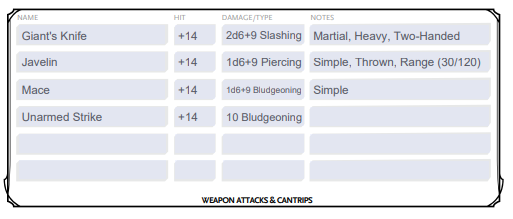
There’s another box, at the bottom of the page, that shows you what you can use to attack on your turn. If you’re a caster, it’ll contain your readied spells as well. This box shows the name of the weapon, your modifier to hit, the damage it does, and any notes associated with the weapon.
Inventory, Gear, and Spells
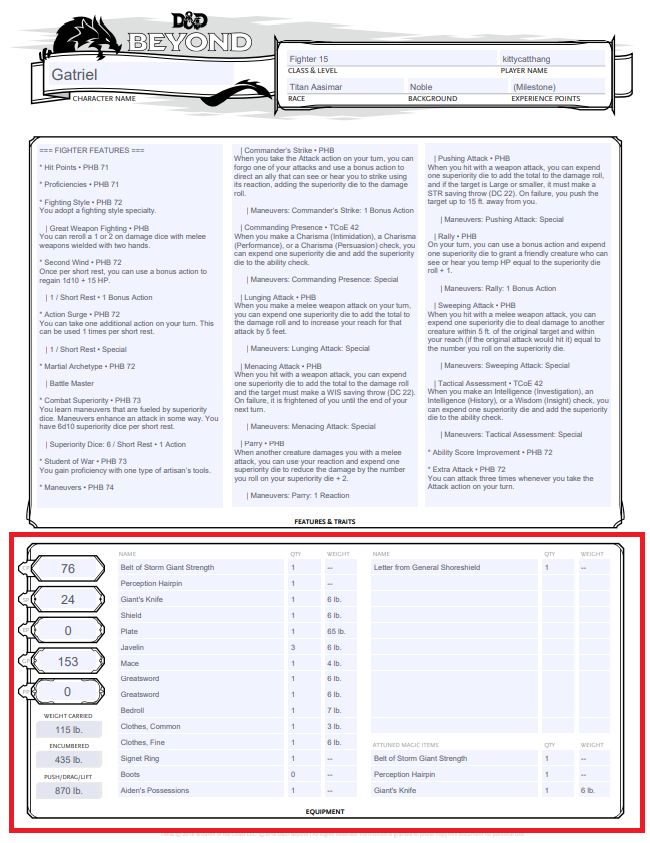
On the second page, skipping over that massive, confusing top section, is a box labeled Equipment. In this box, you get the details of everything your character is holding. It also displays how much money they have and the items they are attuned (magically connected) to.
In the bottom left of this box, you’ll find your character’s carrying capacity. This is the amount of weight they can hold before it gets too heavy. Some DMs completely ignore this while others stick to it strictly when it comes to inventory; be sure to ask your DM what they plan to do.
Devilish Details

Okay, this part is where things get confusing (if you weren’t already confused). The Features and Traits box tells you what benefits and restrictions you gain from your race and class — these can be anything from bonuses to your scores to abilities you can use in battle to language and weapon proficiencies. This box continues on the next page, where it’ll tell you more about feats, or special abilities gained through experience.
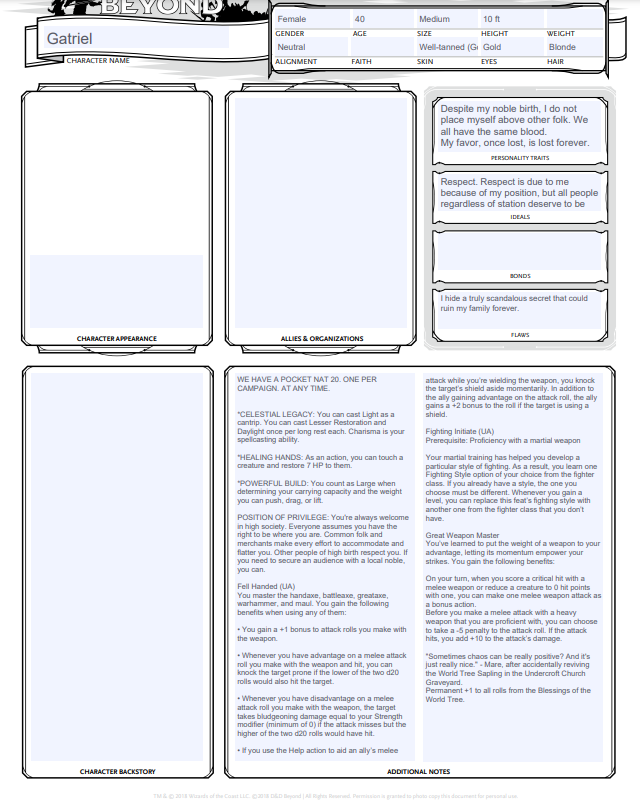
On the next page are several boxes that help flesh out your character from a roleplay standpoint. From left to right and top to bottom, these detail your character’s appearance, alliances and nemeses, personality traits, ideals (what they believe in), bonds (who they believe in), flaws, backstory, and any other notes you have about the campaign.
Up Next — Building a Sheet
Phew, that was a lot of info! Don’t worry, we’ll get into the brass tacks of how these sections actually work in the next part of this series. Be on the lookout for that soon.
For now, though, it’s safe to say that building a character for D&D is complicated. I recommend setting time aside before your campaign starts to build your character; start with what’s easiest for you, whether that’s number-crunching or writing up their story. You should also check with your DM to make sure that you know what rules apply at your table — every game is different, so the building rules for one game will usually be different from the building rules for another.
Experiment, explore what works for you and what doesn't, and remember that if you’re not happy with it, you can always change it later. D&D is all about character, so make sure you’re having fun with yours!
